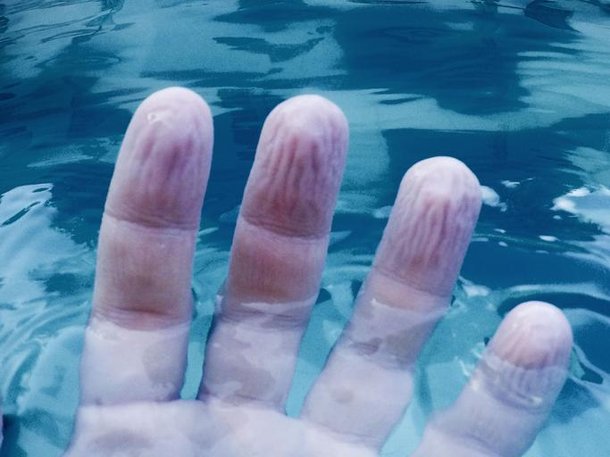O corpo humano tem uma forma muito peculiar de lidar com a água. Basta alguns minutos de contato com o líquido que rapidamente a pele na ponta dos nossos dedos se torna enrugada, precisando de mais alguns minutos fora d’água para readquirir seu aspecto normal.
Mas qual o motivo por trás dessa mudança no nosso corpo? Seria isso um sinal de que nossa espécie se adaptou para ser assim? E quais impactos esse fenômeno tem sobre a nossa saúde atualmente? Nos últimos tempos, pesquisadores se empenharam para obter novas respostas sobre a causa e o propósito desse processo. Veja só!
Mudanças no corpo

O curioso sobre o contato do corpo humano com a água é que apenas a ponta dos nossos dedos dos pés e das mãos é que ficam enrugadas durante esse tempo, enquanto outras partes permanecem iguais, independente se ficamos horas na piscina ou no mar. Porém, tudo tem uma explicação.
É preciso 3,5 minutos em água morna — em temperatura próxima aos 40?°C — para que as pontas dos nossos dedos comecem a se enrugar. Em temperaturas mais baixas, esse processo pode demorar até 10 minutos. De acordo com os pesquisadores, o enrugamento máximo ocorre com 30 minutos de contato com a água.
Em 1935, cientistas aram a suspeitar que tudo está relacionado com o chamado “nervo mediano”, uma vez que pacientes com problema nessa estrutura não sofriam os mesmos efeitos de enrugamento. O nervo mediano é responsável por controlar atividades como o nosso suor e a constrição dos vasos sanguíneos, uma descoberta que sugere que o efeito nas pontas dos dedos está relacionado com o nosso sistema nervoso.
Vantagens do enrugamento

Um estudo feito com 500 voluntários no Museu de Ciências de Londres, em 2020, mostrou que as rugas nos nossos dedos são essenciais para que os humanos tenham mais fricção entre os dedos e objetos quando estamos dentro da água, fornecendo maior aderência para realizar tarefas mais difíceis em ambientes úmidos.
Sem esse mecanismo, nós provavelmente não teríamos a força necessária para realizar algumas tarefas e nossos músculos ficariam ainda mais cansados com o tempo. Alguns cientistas sugeriram que as rugas nas pontas dos nossos dedos podem funcionar como as ranhuras em um pneu de chuva, ajudando a retirar a água em pontos de contato.
Dessa forma, é possível que os humanos tenham evoluído em algum ponto da história para enrugar os dedos das mãos e dos pés de forma que nos ajudasse a segurar objetos e andar sobre superfícies úmidas. Possivelmente, então, o mecanismo de enrugamento ajudou nossos ancestrais a andar sobre pedras molhadas e segurar-se em galhos de árvores — ou simplesmente coletar alimentos como mariscos.
Esse é um processo que acontece com outros primatas, como os macacos-japoneses, mas estudos mais aprofundados ainda não foram feitos com parentes mais próximos. Ainda existe um longo caminho a se percorrer quando falamos sobre esse fenômeno do nosso corpo. Porém, ao que tudo indica, a ciência está progredindo.
Fonte : MegaCurioso.